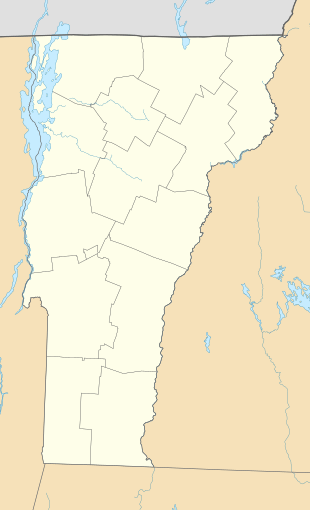Rokeby (Ferrisburg, Vermont)
|
Rokeby | |
|
| |
 | |
| Location | 4334 US 7, Ferrisburgh, Vermont |
|---|---|
| Coordinates | 44°13′21″N 73°14′17″W / 44.22250°N 73.23806°WCoordinates: 44°13′21″N 73°14′17″W / 44.22250°N 73.23806°W |
| Area | 85 acres (34 ha) |
| Built | c. 1780s |
| Architectural style | Other |
| Governing body | Private |
| NRHP Reference # | 74000201 |
| Significant dates | |
| Added to NRHP | June 20, 1974[1] |
| Designated NHL | December 9, 1997[2] |
Rokeby is a historic farm property and museum at 4334 United States Route 7 in Ferrisburgh, Vermont. The 90-acre (36 ha) property includes a 1780s farmstead, and eight agricultural outbuildings with permanent exhibits. Hiking trails cover more than 50 acres (20 ha) of the grounds. Rokeby is open from mid-May to mid-October each year. The property was designated a National Historic Landmark in 1997 for its association with Rowland T. Robinson, a Quaker and ardent abolitionist who openly sheltered escaped slaves here as part of the Underground Railroad. Robinson's extensive correspondence is an essential archive giving insight into the practices of abolitionists and the operations of the railroad.
Description and history
Rokeby is set on the east side of United States Route 7 in the rural community of Ferrisburgh. The central focus of the property is a cluster of buildings, including the 1780s main house, a smokehouse, hen house, outhouse, creamery, toolshed, and other agricultural buildings. The property also includes foundational remnants of a barn and a school. The main house is a two-story Federal style wood frame structure, with an older 1-1/2 story frame Cape style ell attached to its rear. What is now the main block of the house was built in 1814; the ell was built as a freestanding house in the 1780s by the Dakin family, who cleared the land. In 1793 the property was purchased by Thomas Robinson, a Quaker from Newport, Rhode Island.[3]
The house was the home for almost 200 years of the Robinson family, who were millers, farmers, abolitionists, authors, naturalists, and artists. In the 1830s and 1840s, under the auspices of Rowland Thomas Robinson, Rokeby served as a safe house along the Underground Railroad. Letters from the family of Rowland T. and Rachel Gilpin Robinson, devout Quakers and radical abolitionists, mention fugitive slaves by name and in some detail.[4] The record of their correspondence gives an important view into the practices and methods of abolitionists and the details of the operation of the Underground Railroad.[3]
Rokeby was listed on the National Register of Historic Places in 1974, and was declared a National Historic Landmark in 1997.[2][3]
Notable resident
- Delia Webster, abolitionist and teacher
See also
- List of National Historic Landmarks in Vermont
- National Register of Historic Places listings in Addison County, Vermont
References
- ↑ "National Register Information System". National Register of Historic Places. National Park Service. 2007-01-23.
- ↑ 2.0 2.1 "Rokeby". National Historic Landmark summary listing. National Park Service. Retrieved 2008-02-19.
- ↑ 3.0 3.1 3.2 Jane Williamson (January 13, 1997). "National Historic Landmark Nomination: Rokeby / Rowland T. Robinson House" (pdf). National Park Service. and Accompanying 18 photos, from 1996 and undated PDF (32 KB)
- ↑ http://www.rokeby.org/underground.html Rokeby Museum: Underground Railroad
External links
| ||||||||||||||||||||||||||
| ||||||||||||||||||||||||||